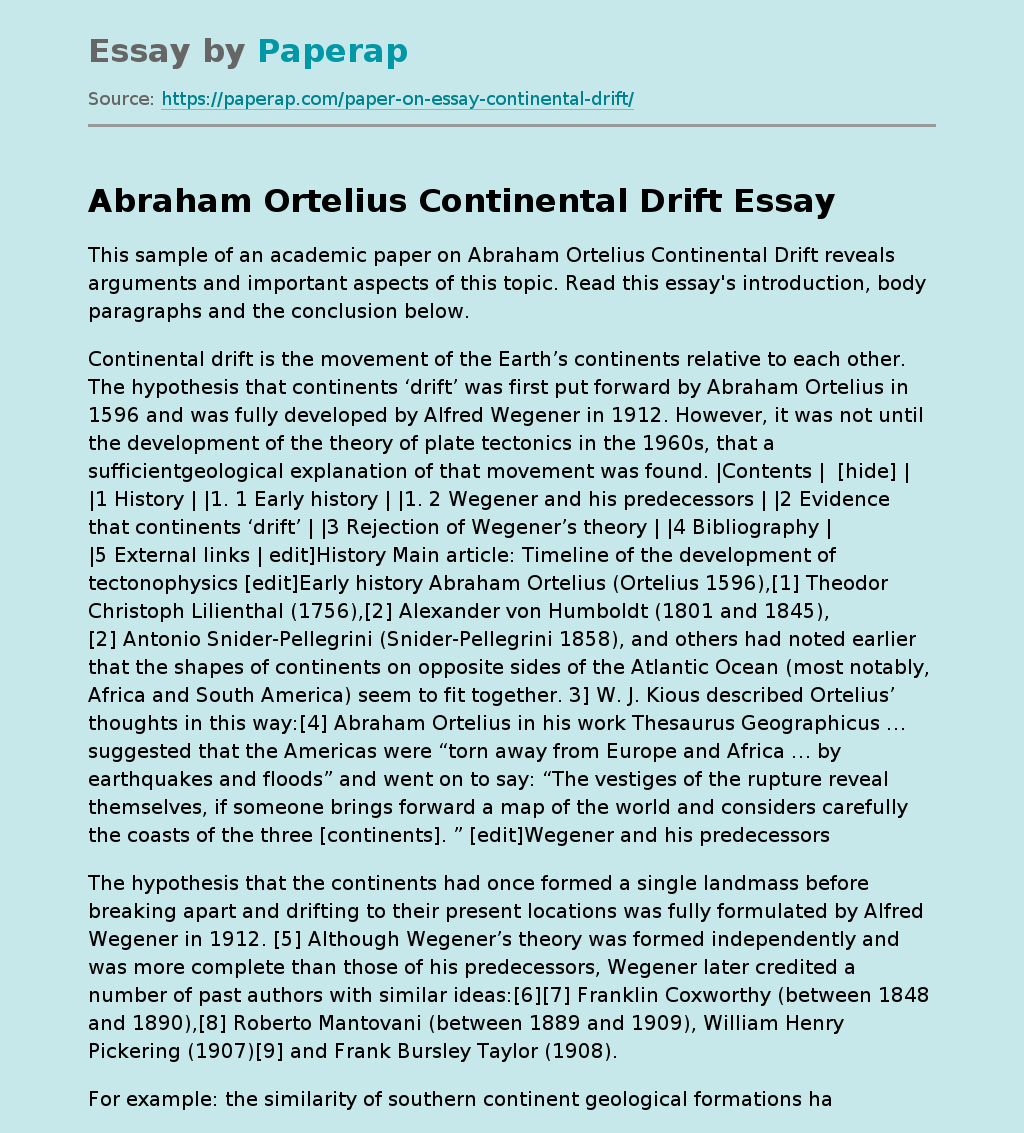Abraham Ortelius Continental Drift
This sample of an academic paper on Abraham Ortelius Continental Drift reveals arguments and important aspects of this topic. Read this essay’s introduction, body paragraphs and the conclusion below.
Continental drift is the movement of the Earth’s continents relative to each other. The hypothesis that continents ‘drift’ was first put forward by Abraham Ortelius in 1596 and was fully developed by Alfred Wegener in 1912. However, it was not until the development of the theory of plate tectonics in the 1960s, that a sufficientgeological explanation of that movement was found.
The hypothesis that the continents had once formed a single landmass before breaking apart and drifting to their present locations was fully formulated by Alfred Wegener in 1912. Although Wegener’s theory was formed independently and was more complete than those of his predecessors, Wegener later credited a number of past authors with similar ideas: Franklin Coxworthy Roberto Mantovani, William Henry Pickering and Frank Bursley Taylor.
The Theory Of Continental Drift Was Formulated Because
This led Mantovani to propose an Expanding Earth theory which has since been shown to be incorrect.
Some sort of continental drift without expansion was proposed by Frank Bursley Taylor, who suggested in 1908 that the continents were dragged towards the equator by increased lunar gravity during the Cretaceous, thus forming the Himalayas and Alps on the southern faces. Wegener said that of all those theories, Taylor’s, although not fully developed, had the most similarities to his own.
Wegener was the first to use the phrase “continental drift” and formally publish the hypothesis that the continents had somehow “drifted” apart.
Although he presented much evidence for continental drift, he was unable to provide a convincing explanation for the physical processes which might have caused this drift. His suggestion that the continents had been pulled apart by the centrifugal pseudoforce of the Earth’s rotation or by a small component of astronomical precession was rejected as calculations showed that the force as not sufficient. The Polfluchthypothesis was also studied by Paul Sophus Epstein in 1920 and found to be implausible. Evidence that continents ‘drift’ Fossil patterns across continents. Mesosaurus skeleton, MacGregor, 1908. For more details on this topic, see Plate tectonics. Evidence for continental drift is now extensive. Similar plant and animal fossils are found around different continent shores, suggesting that they were once joined.
The fossils of Mesosaurus, a freshwater reptile rather like a small crocodile, found both in Brazil and South Africa, are one example; another is the discovery of fossils of the land reptile Lystrosaurus from rocks of the same age from locations in South America, Africa, and Antarctica. There is also living evidence — the same animals being found on two continents. Some earthworm families are found in South America and Africa, for instance.
The complementary arrangement of the facing sides of South America and Africa is obvious, but is a temporary coincidence. In millions of years, slab pull and ridge-push, and other forces of tectonophysics will further separate and rotate those two continents. It was this temporary feature which inspired Wegener to study what he defined as continental drift, although he did not live to see his hypothesis become generally accepted. Widespread distribution of Permo-Carboniferous glacial sediments in South America, Africa, Madagascar, Arabia, India, Antarctica and Australia was one f the major pieces of evidence for the theory of continental drift. The continuity of glaciers, inferred from oriented glacial striations and deposits called tillites, suggested the existence of the supercontinent of Gondwana, which became a central element of the concept of continental drift. Striations indicated glacial flow away from the equator and toward the poles, in modern coordinates, and supported the idea that the southern continents had previously been in dramatically different locations, as well as contiguous with each other. Rejection of Wegener’s theory
While it is now accepted that the continents do move across the Earth’s surface – though more in a driven mode than the aimlessness suggested by “drift” – as a theory, continental drift was not accepted for many years. One problem was that a plausible driving force was missing. And it did not help that Wegener was not a geologist. As late as 1953 – just five years before Carey introduced the theory of plate tectonics – the theory of continental drift was rejected by the physicist Scheiddiger on the following grounds. First, it had been shown that floating masses on a rotating geoid would collect at the equator, and stay there.
This would explain one, but only one, mountain building episode between any pair of continents; it failed to account for earlier orogenic episodes. Second, masses floating freely in a fluid substratum, like icebergs in the ocean, should be in isostatic equilibrium. Gravitational measurements were showing that many areas are not in isostatic equilibrium. Third, there was the problem of why some parts of the Earth’s surface should have solidifed while other parts were still fluid.
Various attempts to explain this foundered on other difficulties. It is now known that there are two kinds of crust, continental crust and oceanic crust. Continental crust is inherently lighter and of a different composition to oceanic crust, but both kinds reside above a much deeper fluid mantle. Oceanic crust is created at spreading centers, and this, along with subduction, drives the system of plates in a chaotic manner, resulting in continuous orogeny and areas of isostatic imbalance. The theory of plate tectonics explains all this, including the movement of the continents, better than Wegener’s theory.
Abraham Ortelius Continental Drift. (2019, Dec 06). Retrieved from https://paperap.com/paper-on-essay-continental-drift/

